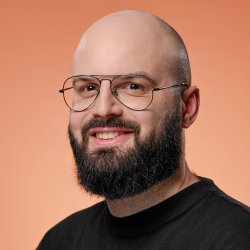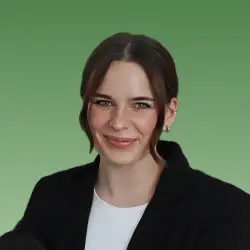9 Keyword Metrics to Track and Measure in 2026
Table of contents
To truly succeed, you need to track the right keyword metrics. They tell you what’s working, what needs improvement, and where the untapped potential lies. For example, thanks to monitoring keyword metrics, you can see how your brand is perceived or select keywords that will drive high-quality traffic to your website.
Keyword metrics are data points that show the performance and value of a particular keyword. They evaluate various aspects, and that’s why they are essential in digital marketing, especially search engine optimization (SEO).
Thanks to the metrics, you can conduct keyword research, monitor the performance of your brand-related keywords, discover user behavior patterns, and make smarter, data-driven decisions to improve your strategy.
With countless keyword metrics, I’ve narrowed it down to the 9 MUST-TRACK!
I will show them to you using different kinds of keywords. Are you ready?
Let’s go!
The most important keyword metrics to track:
01 Search volume
Search volume is a basic SEO metric. It tells you how often a term is searched for in a given timeframe in a particular location.
It reveals what topic users are interested in. By analyzing search volume, you can:
- Discover relevant keywords for your content strategy.
- Find target keywords to attract more traffic to your website and more potential sales.
- Spot seasonal trends in searches and plan your campaigns more effectively.
How to measure?
To check the search volume, you can use these tools:
- Semrush – provides the average number of monthly search volume for an analyzed keyword over the last 12 months

- Ahrefs – like Semrush, it estimates the average monthly number of searches for a keyword over the past 12 months

- Google Trends – does not show actual search volume numbers but provides a relative scale from 0 to 100, where 0 means no interest
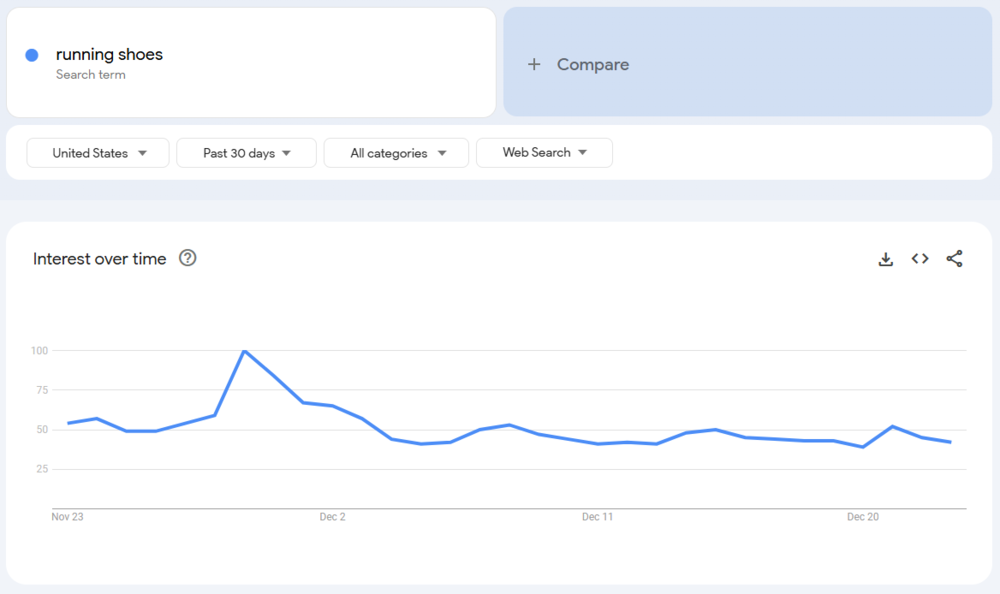
- Google Keyword Planner – offers detailed insights into keyword search volume (option for planning PPC campaigns)
Note: These tools also provide global search volume for any keyword. It is the sum of the keyword’s monthly search volumes across all the countries in their databases.
Track keyword metrics!
02 The volume of mentions
The volume of mentions shows how many times a particular keyword appears online, including social media, forums, blogs, and other sites.
This metric is another way to determine the popularity of keywords.
A high number of mentions is a clear sign that this keyword presents a great opportunity – you should consider using it in your content or campaigns.
Tracking mentions of your brand-related keywords also provides valuable insights into your brand presence. The more mentions your keywords receive, the stronger your brand awareness is.
So, the volume of keyword mentions:
- Reveals what topics are capturing people’s attention
- Provides insights into how well your brand or content resonates
- Helps you identify opportunities to engage with your audience
How to measure?
The only way to effectively measure the volume of mentions is by using keyword monitoring tools like Brand24.
Once you have created a project with a particular keyword, Brand24 tracks when and where it is mentioned.
This tool shows the exact content of mentions containing your keyword:

And with just a click of the “visit” button, you’ll be taken directly to the source of the mention:
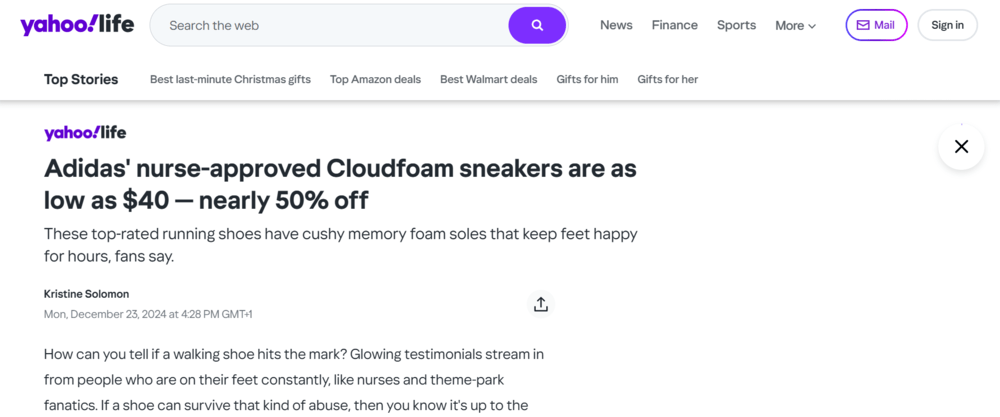
Brand24 also provides a graph that shows the number of mentions over time, making it easy to spot trends. The blue line represents mentions:

What’s more, the Anomaly Detector highlights sudden spikes in mentions and explains what they are caused by:

Note: Brand24 gives you complete control over where to track your keywords. You can monitor the entire web or narrow your focus to a single platform, like TikTok.
03 Keyword difficulty
Keyword difficulty (KD) is a metric that shows how challenging it is to rank on the first page of Google search results for a specific keyword.
The higher the difficulty score, the harder it will be.
Thanks to measuring it, you can, for example:
- Focus on keywords with lower difficulty to achieve faster results
- Avoid wasting time and money on keywords that are too competitive
- Create a perfect SEO strategy
How to measure?
SEO tools, such as Semrush and Ahrefs, provide this metric.
In Semrush, keyword difficulty is expressed as a percentage, where:
- 0-14% – very easy
- 15-29% – easy
- 30-49% – possible
- 50-69% – difficult
- 70-84% – hard
- 85-100% – very hard

What’s more, you can put your site’s domain, and you will get a personal keyword difficulty (PKD) based on your website authority:

Meanwhile, in Ahrefs, keyword difficulty is expressed using a scale from 0 to 100, where:
- 0-10 is easy (<10 domains)
- 11-30 is medium (11-36 domains)
- 31-70 is hard (37-200 domains)
- 71-100 is super hard (200+ domains)
Note: The scale is not linear. Each value corresponds to the estimated number of referring domains (RDs) a page needs to appear on the first page of search results.

Here’s a comparison of the keyword difficulty scores for “running shoes” from above mentioned tools:
In Semrush, the KD for this keyword is 68% (difficult), indicating you’d need around 85 referring domains to compete effectively with others. However, the PKD for the domain runnersworld.com is much lower (34%).
In Ahrefs, the KD is 72 (super hard), meaning that you’d need 224 referring domains to appear on the first page of search results.
Conclusion? “Running shoes” is a highly competitive keyword.
04 Total reach
This metric is directly connected to the volume of mentions. It gives you a view of how many people have seen content where a specific keyword is mentioned.
Total reach is the sum of:
- Social media reach – the number of unique social media users who have seen content mentioning a particular keyword.
- Non-social media reach – the number of people exposed to mentions on platforms outside of social media, such as blogs, forums, or news sites.
By measuring reach, you can assess the online visibility of your brand, campaigns, or other keywords.
It helps you evaluate how effectively your content is reaching your target audience.
How to measure?
The only way to measure the reach of a keyword is to use third-party tools.
Brand24 tracks keyword reach in real-time, showing social and non-social media reach:

For example, the total reach of the keyword “Adidas” in the last week is 140 MILLION (!):
- 137 MILLION is social media reach
- 2.6 MILLION is non-social media reach
Brand24 also shows how the total reach changes over time (green line) and explains what caused the rise:


Note: You can filter keyword mentions by source, then you will get their reach only within a given source.
Discover keywords that generated the highest reach!
05 Search intent
Search intent explains why people search for something; it’s the purpose behind their query.
Intents can be divided into:
- Informational – users are looking for information or answers to questions
- this intent is often indicated by keywords like “how to…”, “what is…”
- examples: “how to start running”, “what is running good for”
- Navigational – users intend to find a specific website or page
- keywords like brand names often indicate this intent
- examples: “Adidas”, “Nike”
- Commercial – users are researching products or services before making a purchase decision
- this intent is often indicated by keywords like “review”, “best”, “recommendations”
- examples: “running shoes recommendations 2026”, “best running shoes review”
- Transactional – users are ready to take action, such as buying or subscribing
- this intent is often indicated by keywords like “buy”, “order”, “discount”
- examples: “running shoe discount”, “best price running shoes”
You better understand the search intent of your target keyword!
It will help you create content that matches people’s needs and increase your chances of ranking higher in search results.
How to measure?
Of course, you can determine the search intent by analyzing top-ranking pages manually. But this method is quite inefficient.
The best way?
Use keyword research tools like Semrush.
All you need to do is enter your keyword into the Keyword Overview tool, and the search intent will appear alongside other SEO metrics.

06 Mention intent
This metric is very similar to search intent.
Mention intent identifies the reason behind people mentioning a specific keyword. It can be entertaining, informational, promotional, emotional, etc.
Thanks to this metric, you can quickly:
- Discover what kind of content gains the biggest audience & generates the most interactions, then create content that resonates the best
- Spot opportunities to fill gaps in current discussions by creating content that introduces something innovative and fresh
How to measure?
To discover mentions intent, use a media monitoring tool like Brand24.
It analyzes the context of mentions and categorizes them based on intent:

This tool also identifies which intents reach your audience the most and which achieve the greatest engagement:
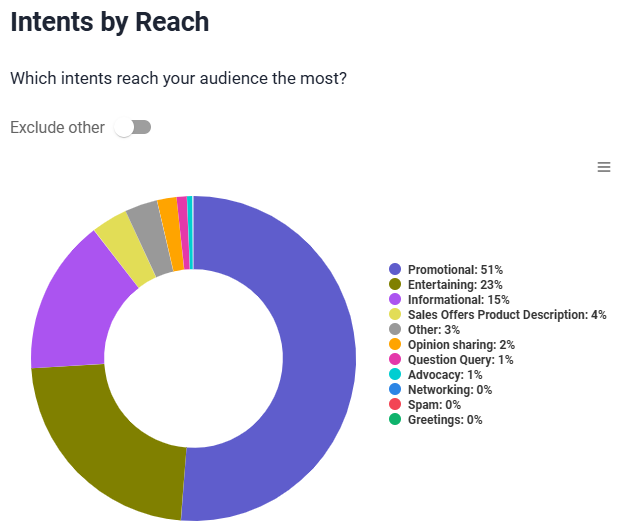

Check your mentions intent!
07 Sentiment
Sentiment literally tells how people feel about a specific topic, product, or brand – whether their opinions are positive, negative, or neutral.
It’s a critical keyword metric!
Depending on your keyword type, sentiment analysis gives you many different benefits!
You can:
- Gain a better understanding of how customers perceive your brand or product.
- Identify areas that need improvement.
- Monitor your brand reputation in real-time and respond promptly to feedback.
- Quickly see if a particular keyword is used in a positive, negative, or neutral context.
How to measure?
Sentiment analysis must be done using social listening tools, such as Brand24.
It automatically analyzes online mentions of any keyword and determines their sentiment.

Brand24 also detects which source generates the most negative sentiment:

It’s especially useful when you track brand-related keywords!
08 Share of voice
SOV (Share of Voice) tells how many conversations a given keyword captures compared to competitors.
For example, if the keyword “Adidas” has a higher SOV than its competitor, Nike, that’s good for Adidas – it means that people are more likely to talk about Adidas and use this keyword than Nike.
How to measure?
You can calculate SOV by dividing the volume of your keyword mentions (or reach) by the total number of mentions (or reach), which is the sum of your and competitors’ keyword mentions (or reach). Then multiply by 100 to get the percentage.
SOV = (number of your keyword mentions or reach / total number of keywords’ mentions or reach) x 100
But let’s be honest – who calculates SOV manually these days? Definitely not me!
With Brand24, you can skip the hard work.
Just define keywords for comparison; the tool does all the work for you.
It provides total SOV, social media SOV, and non-social media SOV for keyword mentions and reach.

As you can see, it turned out that people are talking more about Nike than Adidas!
Nike not only dominates in terms of reach (78%) but also in terms of mentions (70%).
Measure the SOV of your keywords!
09 AVE
Last but not least – AVE (Advertising Value Equivalent)!
It shows how much money you would’ve had to spend on ads to generate the same amount of organic exposure your keyword achieved.
How to measure?
It’s not easy to calculate this metric by yourself, and very few tools can do it.
One of those tools is Brand24.

Moreover, it shows how much money you save thanks to mentions in a particular source!
So let’s check out the keyword “Adidas Gazelle”, one of Adidas’ shoe models:

It comes out that the AVE for the keyword “Adidas Gazelle” in the last 30 days is almost 500 thousand, and over 51% of that value is generated by X (Twitter).
X (Twitter) still has a lot of power!
What is the AVE of your keyword?
Tip: Advanced tools can analyze metrics for you
If you carefully look at the metrics I’ve described, you probably notice that measuring them is only possible with the right tools.
AI tools like Brand24 analyze keywords precisely and provide actionable insights, saving time and effort.
You can track any keyword you want, for example:
- Brand-related keywords
- your brand name: Adidas, Coca-Cola, Audi
- product names: Adidas Gazelle, Diet Coke, Audi Q8
- campaign hashtags: #ImpossibleIsNothing, #ShareACoke, #WantAnR8
- Competitor keywords
- competitor brand names: Nike, Pepsi, BMW
- competitor product names: Nike Air Max, Pepsi MAX, BMW X5
- Industry keywords
- running shoes, soft drinks, luxury cars
- Seasonal keywords
- holiday-specific and event-related terms: Black Friday sneaker deals, FIFA World Cup, Geneva Motor Show
- Long-tail keywords
- best running shoes for men, healthy alternatives to soda, affordable luxury SUVs for families
In Brand24’s Metrics Analysis tab, you will find the most important insights, including:
- A summary of the keyword you are monitoring

- Identification of the most reach-efficient sources (very helpful to identify where you should focus your efforts)

But the real game-changer is the Brand Assistant!
Do you have a tricky question about your keyword? Or need help with any task?
This AI-powered Assistant will always help you – you just have to ask him nicely 😉

Try Brand Assistant and get AI insights!
Conclusion
Tracking keyword metrics is a critical part of any data-driven marketing strategy!
It’s worth using tools that automatically measure the right metrics, analyze them, and deliver actionable insights that you can use immediately.
By tracking keyword metrics, you will:
- Learn about the needs, questions, and interests of your target audience
- Understand which keywords generate the most reach and engagement
- Discover how your brand is perceived
- Learn what content positions the best
- Find the right keywords for your strategy
- Be able to react quickly to changes in the market
Have you already found a tool that monitors the key metrics of every keyword you want?
Check out Brand24 during your 14-day free trial – discover the number of keyword mentions, reach, sentiment, and more!



